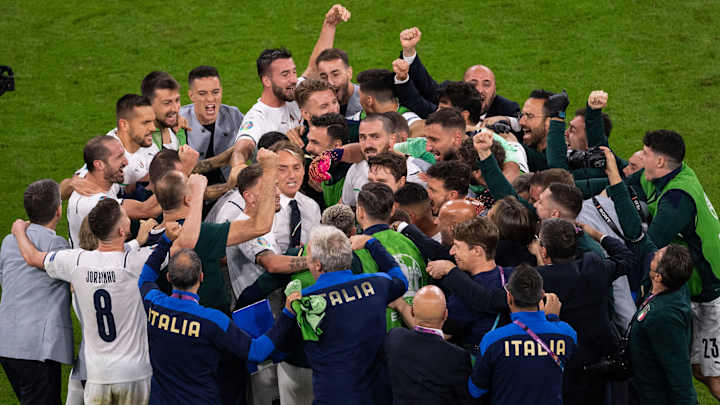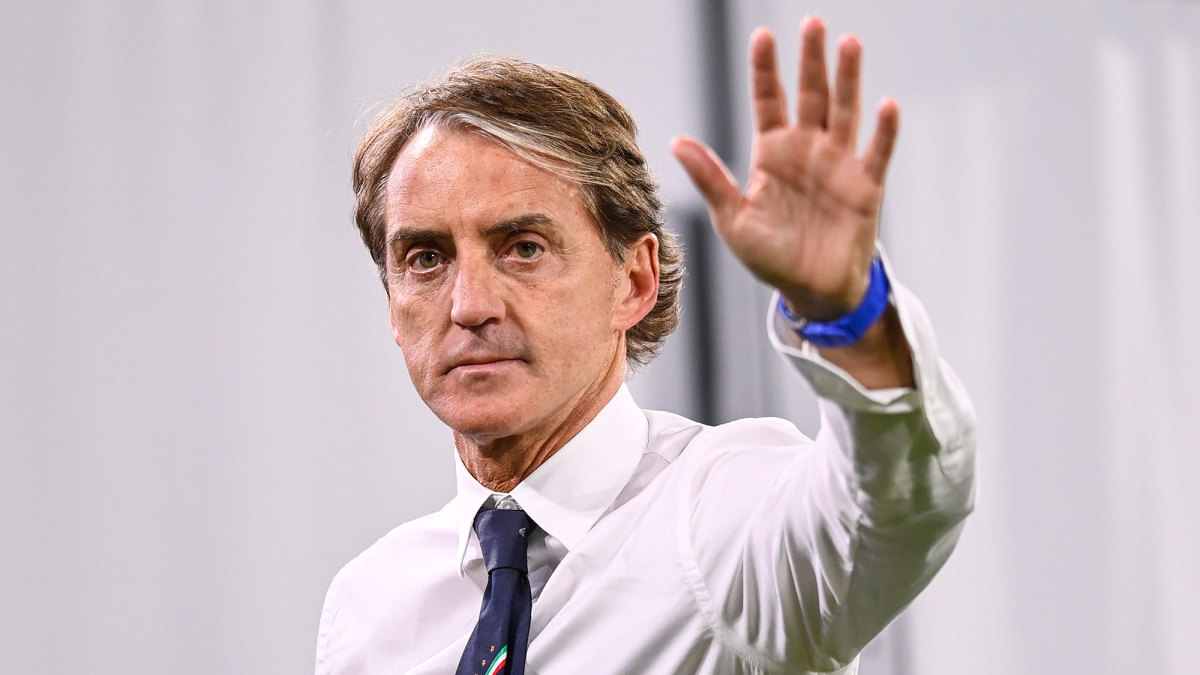For Euro Finalist Italy, Missing the World Cup Wasn't the End

It was the sort of word choice and presentation that might be appropriate for an invasion or the day after the alien mothership arrives. The front page of La Gazzetta dello Sport on Nov. 14, 2017, screamed “FINE” in massive, bold capital letters that left no doubt that this was, indeed, the end. It was not a moment for nuance, context or perspective. Italy, a four-time champion and global football heavyweight, had failed to qualify for the 2018 World Cup.
The Azzurri had slipped from their perch after earning a fourth star in 2006, with a blowout loss to Spain in the Euro 2012 final sandwiched by group-stage exits (and only one victory) in the 2010 and ’14 World Cups. So considering the fine margins in international soccer, any team far from its best is already tempting fate. Italy then was handed a tough draw in 2018 qualifying. A 7-1-2 record left the Azzurri trailing Spain and forced into a playoff.
There, Italy’s issues were laid bare. Manager Gian Piero Ventura lacked high-level experience, had difficulty matching tactics to personnel and failed to refresh a squad that featured too many starters in their 30s. The federation had been reluctant to fire Ventura even as problems began to surface and after failing to score over two legs against Sweden—despite outshooting the visitors 27-4 during the playoff decider in Milan—Italy was out.

FIGC president Carlo Tavecchio said a month earlier that, “not qualifying for the World Cup would be an apocalypse.” It’s an understandable opinion. Italy wasn’t just a tournament fixture. It was a pillar of global football, one of the spiritual and historic centers of the game. Calcio was integral to Italian culture and identity. To be excluded from its showpiece event, to fail at what’s most important, probably felt like an assault on that sense of self. That’s traumatic. Maybe it really seemed like the world was ending.
Except it didn’t. Here Italy stands less than four years later, upright and boisterous like when its players belt out their national anthem. The Azzurri are back, and now are one game away from their first European Championship crown since 1968. And their 4-0-1 record at the tournament that ends Sunday against England has extended the unbeaten streak under coach Roberto Mancini to 33 games (the world record is 35).
Although Italy was fortunate to escape Spain, again, in Tuesday’s relatively one-sided semi, it’s hard to argue that Mancini’s squad doesn’t deserve its place in the Wembley final. During the Euro and over the past couple years, Italy has evolved into a proactive and dynamic side that features numerous players with laudable individual skill, range and ambition—the qualities that seemed to be absent during that desultory World Cup qualifying campaign.
"The desire to rebuild, to relive a tournament as a protagonist is immense," veteran defender Giorgio Chiellini said before the Euro opener. "The defeat in Milan against Sweden stuck with us. We can never forget it. But we managed to turn disappointment into enthusiasm and the desire to do well.”

It’s worth noting that Tavecchio’s descriptor, “apocalypse,” comes from a Greek word meaning “uncover” or “reveal.” Linguistically, an apocalypse isn’t a definitive ending. Rather, it’s a revelation or point of transition. Italy’s failure revealed the need for new ideas, new blood and a new approach. Tavecchio and Ventura were among the departures. Mancini, the Sampdoria legend who coached Inter Milan and Manchester City to league titles, took charge of the Azzurri in the spring of 2018. He was starting from scratch in a way and so could afford to pay less attention to Italy’s strict tactical traditions and those with national team tenure. He proposed that soccer should be fun and started offering opportunities to younger players and those who were overlooked or sidelined by Ventura. By early 2019, Italy was unbeatable.
It’s amazing what a well-executed transfusion can accomplish. A soccer country doesn’t stop being a soccer country when it stumbles or takes a wrong turn. The tradition and infrastructure remain, and pedigree typically is permanent. France missed the 1994 World Cup, then lost a Euro ’96 semi on penalties and won the ’98 World Cup. The Netherlands sat out three major tournaments before winning Euro ’88, and it was absent from the ’02 World Cup before medaling at two of the next three. England also missed ’94, but then was a shootout away from the Euro ’96 final. And after failing to reach Euro ’92, Italy nearly won the World Cup just two years later.
So failure in 2017 wasn’t the end of the Azzurri. In fact, the revolution was already underway thanks to coordinated efforts at the youth level to prioritize individual technical and tactical development over results. Naturally, the results started to come. Italy reached a combined four UEFA U-17 and U-19 finals and two FIFA U-20 World Cup semis between 2016 and ’19. The foundation was there. Some fresh bodies and fresh ideas at the top were all that was needed.

If you follow U.S. soccer, then you’ve inevitably made the comparison already. The American men certainly aren’t a world power, and there’s no domestic analog to La Gazzetta. But what happened nearly four years ago in Couva sure seems similar to what went down in Milan. It was apocalyptic. A regional heavyweight expected to qualify was undone by a player pool that hadn’t been refreshed, bad coaching and a federation president who failed to pull the trigger when necessary (in Jurgen Klinsmann’s case, that was the summer of 2015). Then there was more bad coaching. And still, it was a close call. The U.S. wasn’t good during the 2016-17 Concacaf Hexagonal, yet its elimination was confirmed only by a goal post in Trinidad (and what may have been a phantom goal in Panama City).
Was it the end? There were plenty of concerns that, in a country where soccer isn’t the dominant sport, World Cup failure would have devastating consequences. Fans, media, TV networks or sponsors might conclude American soccer was a lost cause. Talented young athletes could turn to other sports. The haters would have fuel, and the momentum established through decades of effort and meticulous growth would stall. All sorts of doomsday scenarios were contemplated.
But the U.S. is a soccer country—not like Italy of course, but a soccer country nevertheless. The economic and demographic conditions that produce such an advantage in Concacaf didn’t just disappear in October 2017. Millions play and millions watch, and there was a sturdy infrastructure and culture established by past U.S. national team success, MLS, the USL and the professionalization of youth development that began with U.S. Soccer’s academy program in 2007.

President Sunil Gulati and coach Bruce Arena eventually stepped aside. The USSF hired its first sporting director, Earnie Stewart, and GMs for both the men’s and women’s national teams. After a delay that frustrated some, coach Gregg Berhalter was hired in December 2018. He may not have been everyone’s first choice, but he’s a manager who studies and employs modern tactics and who relates well to younger players. And Berhalter quickly committed to giving those young men an opportunity. The team that beat Mexico last month to win the inaugural Concacaf Nations League crown featured a dozen players 22 or younger, and all but one was under 30. There’s new blood, a new approach and more optimism surrounding the U.S. program than ever before. And it’s been less than four years since Couva.
When asked about potential qualifying failure as the U.S. hit a speed bump in 2012, MLS commissioner Don Garber said, "There are countries that haven’t qualified for the World Cup that were pretty good teams. It’s part of the sport that these things happen, and you’ve got to learn to get beyond it.”
Both the U.S. and Italy got beyond it. With the right mix of ruthlessness (those in charge have to go) and patience (let the youngsters play and learn), a coach and executives with courage and fresh ideas, and faith in the long-term strength of the sport, any ending can become a new beginning.
Mancini has given 35 players their international debut. He’s expanded Italy’s tactical framework far beyond catenaccio, and apart from the semifinal slog against Spain, his team has been a high-pressing, ball-playing, front-foot force. The midfield of Jorginho, Marco Verratti and Nicolò Barella, none of whom featured regularly for Ventura, is skillfully dictating play. Attackers like Ciro Immobile and Lorenzo Insigne are flourishing under new management, and Italy became only the second side in European Championship history, after France’s legendary 2000 team, to have at least five players score multiple goals during the tournament.
Dutch legend Johan Cruyff once said, “The Italians can't beat you, but you can certainly lose to them.”
The Italians can beat you now. And this has all happened with a side that started the competition featuring 13 players with 15 caps or fewer and only two, Chiellini and his defensive partner, Leonardo Bonucci, with more than 50 (and they each have over 100).

"I must say that we are very happy about all of this, and I must thank the players because they have believed right from day one that we could produce something incredible,” Mancini said after the semifinal. “That's why I think the players, and everyone that has worked with us over the last three years deserve a lot of credit, because it wasn't easy by any means. Almost no one believed we could do it.
“The players did want to do something different,” he continued. “They wanted to play a brand of football that people enjoyed and thus far they've managed to do exactly that. Difficult tasks are ultimately all the more enjoyable.”
It’s difficult, but hardly impossible, to recover from a setback. Combine some fresh ideas and fresh legs with a bit of humility and pedigree, and that recovery might be expedited. And you don’t have to return to exactly to where you were. Let the next generation set a new course. The U.S. team that will look to make amends when Concacaf’s World Cup qualifying campaign begins in September features a UEFA Champions League winner and players who claimed trophies in each of Europe’s big five nations. It’s energetic, athletic and now accustomed to playing and winning at the highest levels. There’s unprecedented ambition, and there may be no going back.
Italy, meanwhile, is winning again. But now it can do so with aplomb, and it can do so with joy. The Azzurri’s quarterfinal display against top-ranked Belgium was a case study in evolution, as Mancini’s side married its traditionally stalwart defending with an ability to possess, pass and move, press and score goals. It completed 102 more passes than Belgium. And was there any doubt which way the semifinal shootout would go after a goofy, grinning Chiellini manhandled Spain’s Jordi Alba during the coin toss? This was a man who’d seen the bottom, experienced an apocalypse and realized there was a way back. Failure offers perspective and provides fuel, and the Azzurri now have both.
"Our desire to live this European Championship as protagonists is strong,” Mancini said before the tournament.
They’re 90 minutes away from potentially lifting the trophy as protagonists as well.
More Euro 2020 Coverage:
